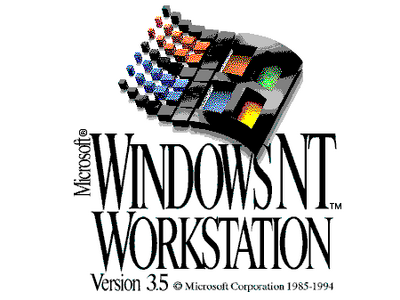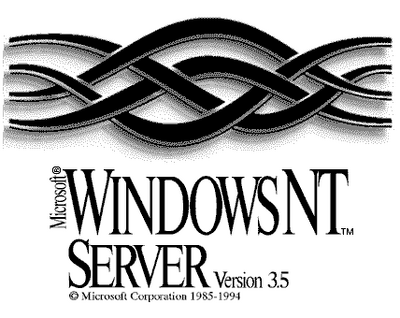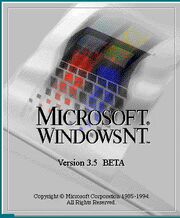No edit summary |
|||
| Line 13: | Line 13: | ||
This is the first Windows NT version to adopt the names ''Windows NT Workstation'' and ''Windows NT Server'' for its editions. The editions of the previous Windows NT release, [[Windows NT 3.1]], were named ''Windows NT'' and ''Windows NT Advanced Server''. The Workstation edition allowed only 10 concurrent clients to access the file server and no Mac clients. The Server edition included all of the functions and network options in this system. |
This is the first Windows NT version to adopt the names ''Windows NT Workstation'' and ''Windows NT Server'' for its editions. The editions of the previous Windows NT release, [[Windows NT 3.1]], were named ''Windows NT'' and ''Windows NT Advanced Server''. The Workstation edition allowed only 10 concurrent clients to access the file server and no Mac clients. The Server edition included all of the functions and network options in this system. |
||
| − | Windows 3.5 included integrated [[Winsock]] and [[TCP/IP]] support. The initial commercially available version of Windows NT |
+ | Windows 3.5 included integrated [[Winsock]] and [[TCP/IP]] support. The initial commercially available version of Windows NT 3.1, included only a proprietary and quite incomplete implementation of TCP/IP based on the AT&T UNIX System V "Streams" API. The TCP/IP and IPX/SPX stacks in Windows 3.5 are rewritten. [[NetBIOS over TCP/IP]] (NetBT) support as a compatibility layer for TCP/IP was introduced as also the Microsoft DHCP and [[Windows Internet Name Service|WINS]] clients and DHCP and WINS servers. |
Windows 3.5 can share files through FTP and printers through LPR and act as Gopher, Web, and [[Wide area information server|WAIS]] servers. The Windows 3.5 Resource Kit included the first implementation of [[Microsoft DNS]]. Windows 3.5 included [[Remote Access Service]] for remote dial-up modem access to LAN services using either SLIP or PPP protocols. |
Windows 3.5 can share files through FTP and printers through LPR and act as Gopher, Web, and [[Wide area information server|WAIS]] servers. The Windows 3.5 Resource Kit included the first implementation of [[Microsoft DNS]]. Windows 3.5 included [[Remote Access Service]] for remote dial-up modem access to LAN services using either SLIP or PPP protocols. |
||
| Line 24: | Line 24: | ||
Windows 3.5 refuses to install on a processor newer than the original [[Intel P5|Pentium]] (P5 core). [[Windows 3.51]] fixed this. It is however possible to modify files on the install CD which will allow it to install. |
Windows 3.5 refuses to install on a processor newer than the original [[Intel P5|Pentium]] (P5 core). [[Windows 3.51]] fixed this. It is however possible to modify files on the install CD which will allow it to install. |
||
| + | |||
==Logos== |
==Logos== |
||
[[File:Windows_nt_3_5_beta-14330.jpg|thumb|left|Daytona (Windows 3.5 Beta)]] |
[[File:Windows_nt_3_5_beta-14330.jpg|thumb|left|Daytona (Windows 3.5 Beta)]] |
||
Revision as of 12:55, 17 April 2019

Microsoft Windows 3.5 Workstation logo screen.

Microsoft Windows 3.5 Server logo.

Microsoft Windows 3.5 desktop screenshot.
Windows 3.5 (codenamed "Daytona") is the second release of the Microsoft Windows NT operating system. It was released on September 21, 1994.
One of the primary goals during Windows 3.5's development was to increase the speed of the operating system; as a result, the project was given the codename "Daytona" in reference to the Daytona International Speedway in Daytona Beach, Florida.
Windows 3.5 was finally succeeded by Windows 3.51 in 1995 and by Windows NT 4.0 in 1996.
Overview

The box art of Windows 3.5.

A screenshot of File Manager on Windows 3.5
This is the first Windows NT version to adopt the names Windows NT Workstation and Windows NT Server for its editions. The editions of the previous Windows NT release, Windows NT 3.1, were named Windows NT and Windows NT Advanced Server. The Workstation edition allowed only 10 concurrent clients to access the file server and no Mac clients. The Server edition included all of the functions and network options in this system.
Windows 3.5 included integrated Winsock and TCP/IP support. The initial commercially available version of Windows NT 3.1, included only a proprietary and quite incomplete implementation of TCP/IP based on the AT&T UNIX System V "Streams" API. The TCP/IP and IPX/SPX stacks in Windows 3.5 are rewritten. NetBIOS over TCP/IP (NetBT) support as a compatibility layer for TCP/IP was introduced as also the Microsoft DHCP and WINS clients and DHCP and WINS servers.
Windows 3.5 can share files through FTP and printers through LPR and act as Gopher, Web, and WAIS servers. The Windows 3.5 Resource Kit included the first implementation of Microsoft DNS. Windows 3.5 included Remote Access Service for remote dial-up modem access to LAN services using either SLIP or PPP protocols.
Other new features in Windows 3.5 include VFAT (ability to use long file names of up to 255 characters), and support for I/O completion ports. It featured a new startup screen. The interface was updated to be consistent with the Windows for Workgroups 3.xx. It also upgraded Object Linking and Embedding (OLE) support from version 1.0 to version 2.0 and is more efficient - performance is higher and it requires less memory than Windows NT 3.1.
Windows 3.5 did not support laptop computers as it had no drivers for PCMCIA adapter cards.
In July 1995, Windows 3.5 with Service Pack 3 was rated by the National Security Agency as complying with TCSEC C2 criteria.
Windows 3.5 refuses to install on a processor newer than the original Pentium (P5 core). Windows 3.51 fixed this. It is however possible to modify files on the install CD which will allow it to install.
Logos

Daytona (Windows 3.5 Beta)
Look up at the non-beta logos
Editions
- Windows 3.5 Workstation
- Windows 3.5 Server
External links
- Guidebook: Windows 3.51 Gallery – A website dedicated to preserving and showcasing Graphical User Interfaces
|
Wikipedia (article: Windows_3.5 )
|
Microsoft Windows family
|
|---|
| Versions • Components • History |
| Original |
| DOS-based |
| Windows 1.0 • Windows 2.0 • Windows 2.1 (Windows/286 • Windows/386) • Windows 3.0 • Windows 3.1 |
| Windows 9x |
| Windows 95 • Windows 98 • Windows Me |
| Windows NT |
| Early versions |
| Windows NT 3.1 • Windows NT 3.5 • Windows NT 3.51 • Windows NT 4.0 • Windows 2000 |
| Client |
| Windows XP (development) • Windows Vista (editions • development) • Windows 7 (editions • development) • Windows 8 • Windows 10 • Windows 11 |
| Windows Server |
| Server 2003 • Server 2008 (2008 R2) • HPC Server 2008 • Home Server • Small Business Server • Essential Business Server • Windows Server 2012 • Windows Server 2016 • Windows Server 2019 • Windows Server 2022 |
| Specialized |
| Windows Embedded • Windows PE • Windows Fundamentals for Legacy PCs |
| Mobile |
| Windows Mobile • Windows Phone |
| Cancelled |
| Cairo • Nashville • Neptune • Odyssey • Windows 10X |
| Related |
| Metro • Midori • OS/2 • Windows Aero • Windows Setup • Windows XP themes • Microsoft Plus! |
